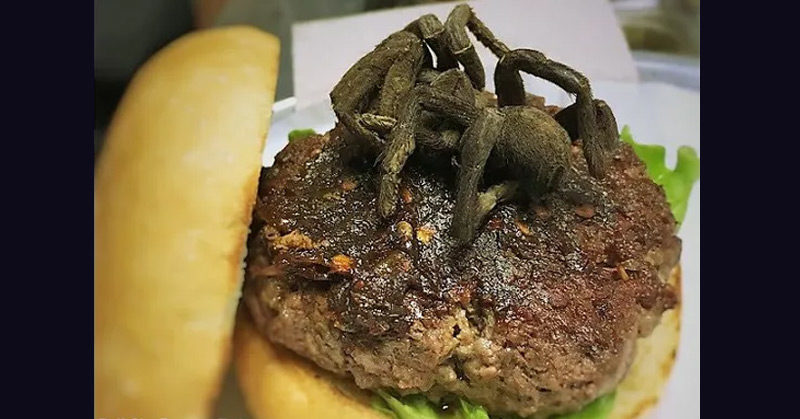Are you a highly adventurous eater who, when it comes to food, you’ll try anything once? If so, then you need to visit this burger joint. No, we’re not talking crazy hot peppers or a burger with 10 patties. This burger is topped with a tarantula.
The Tarantula Burger
Bull City Burger and Brewery in Durham, North Carolina likes to celebrate more out-there burger toppings. The tarantula-topped burger is just one of several crazy concoctions included in their annual “Exotic Meats Month”. (2)
In the month of April, the restaurant and brewhouse serves up patties made of a variety of unusual meats, including (2):
- Alligator
- Bison
- Camel
- Python
- Venison
- Turtle
- Wild Boar
- Ostrich
- Duck
- Caribou
- Reindeer
- Rabbit
- Bugs
- Goat
- Rocky Mountain Oysters
- Elk
- Turkey
- Yak
- Kangaroo
- Emu
This year’s “spider burger” is the talk of the town, however. Bull City hosted the “Tarantula Challenge” which of course involves eating the $30 arachnid-topped burger, right down to all eight of its legs. (1)
The restaurant only makes one each day, so in order to have a chance to try it you first must enter a raffle, then if your name is drawn you have 48 hours to claim your spot. If you eat the entire thing you get a special t-shirt as a reward to be used for proof later. (1)
So what does a tarantula taste like? According to those who ate the burger, it tastes sort of like a shellfish. Personally, I think I will just take their word for it. (1)
But how Disgusting is it, Really?
In North America, we look at eating things like tarantulas or many of the meats listed above as weird, strange, and down-right disgusting. How gross is it really, though? (3)
Much of what we determine as abnormal or disgusting is based on the environment we were raised in. For example, if you grew up in a coastal town, chances are you grew up eating plenty of fish and seafood. If you were raised on a cattle farm, you probably ate a lot of beef. Similarly, if you were raised in a place with kangaroo instead of deer or where insects are considered a delicacy, you won’t find eating those things weird. (3)
Read: A 425-Pound Tiger Living in a Harlem Apartment? Yes, It Happened
The Role of Religion
There is often the religious context for what foods are off-limits for some and not others. If you are Muslim for example, you don’t eat pork, if you are Hindu you don’t eat beef, and if you are Jewish you don’t eat pork or shellfish. (3)
The Role of Culture
Cultural context is also huge for this. If your family comes from India, you would have grown up eating very differently than someone who’s family is Korean, or Swedish, or Irish, or American. Within North America, there is a huge range of what people eat depending on what area they are from. If you come from an area that has a ton of alligators, guess what people have probably been eating for a really long time? That’s right, ‘gators. (3)
In North America, we especially like to talk about all the “crazy” foods they eat in other countries, in particular Asian ones, but have any of us stopped to consider what people think of our diets? Ask someone about American food and you’ll probably hear:
- Why is everything so big?
- Does everything have to be so sweet or salty?
- Why do they eat so many things that come out of boxes?
- What is Cheeze Whiz and why is it spelled with a “z”?
- Do Americans put cheese on everything? Why?
- Why do Americans throw away “x” part of the animal? It has so many uses!
That’s right, what most of us consider to be “normal” is really just “normal to us”. Take a trip around the world, or even just to specific neighborhoods in your city, and you will start to see it.
The Role of the Time Period
The time period you grew up in will also play a role in this. In post-World War II North America, canned foods and meals (including canned bread) really took off. What were known as “aspic salads” also took off during this time frame. These were dishes where the ingredients – eggs, vegetables, meats, etc – were set into a gelatin made from meat stock. That’s right, it was meat Jell-O.
The Role of Family
Finally, our family influence has a huge impact on what we do and don’t find strange in the kitchen. Maybe your family grew up eating peanut butter and tomato sandwiches, maybe your mom used plain yogurt instead of cream cheese on bagels because it was cheaper. Whatever unique food habits you grew up with, you probably didn’t realize they weren’t “normal” until you went to school. Most likely you’ve spent every day since telling people “don’t knock it until you’ve tried it!”.
The Bottom Line
All this talk of cultural context and what “normal” really means aside, does that mean you are close-minded if you still don’t want to eat the tarantula burger? Of course not. At the end of the day, if you don’t want to eat something, you don’t have to.
What you do want to think about is how you react to a food that someone else does like or want to try. Making someone else feel bad or embarrassed about themselves and their culture just because the food they are eating isn’t a part of yours is not okay.
So to the adventurous eaters, go for it – try all the foods. For those who prefer to stick to what they know, you can ask the others what tarantula tastes like afterward.

